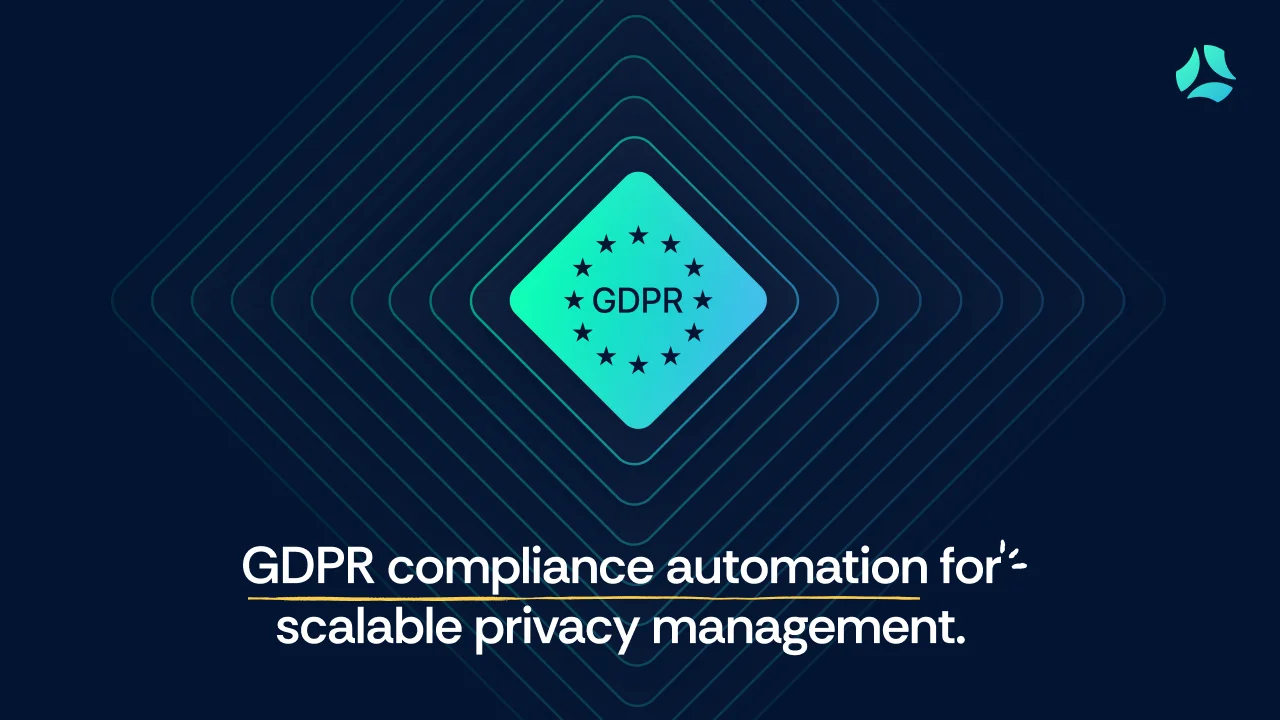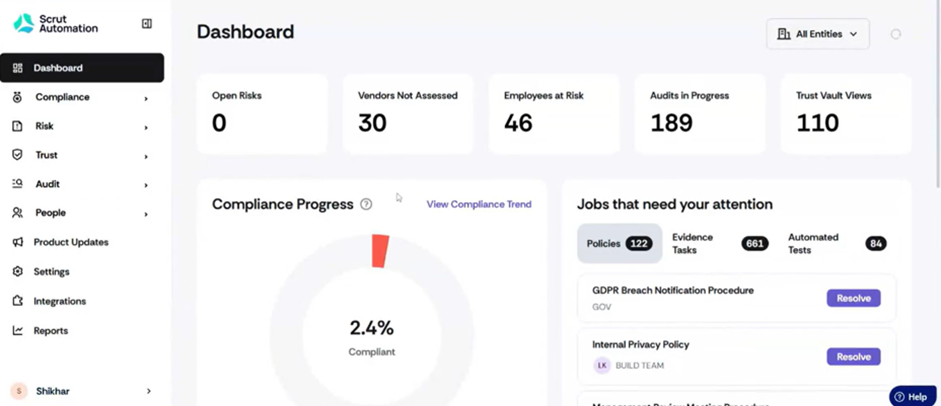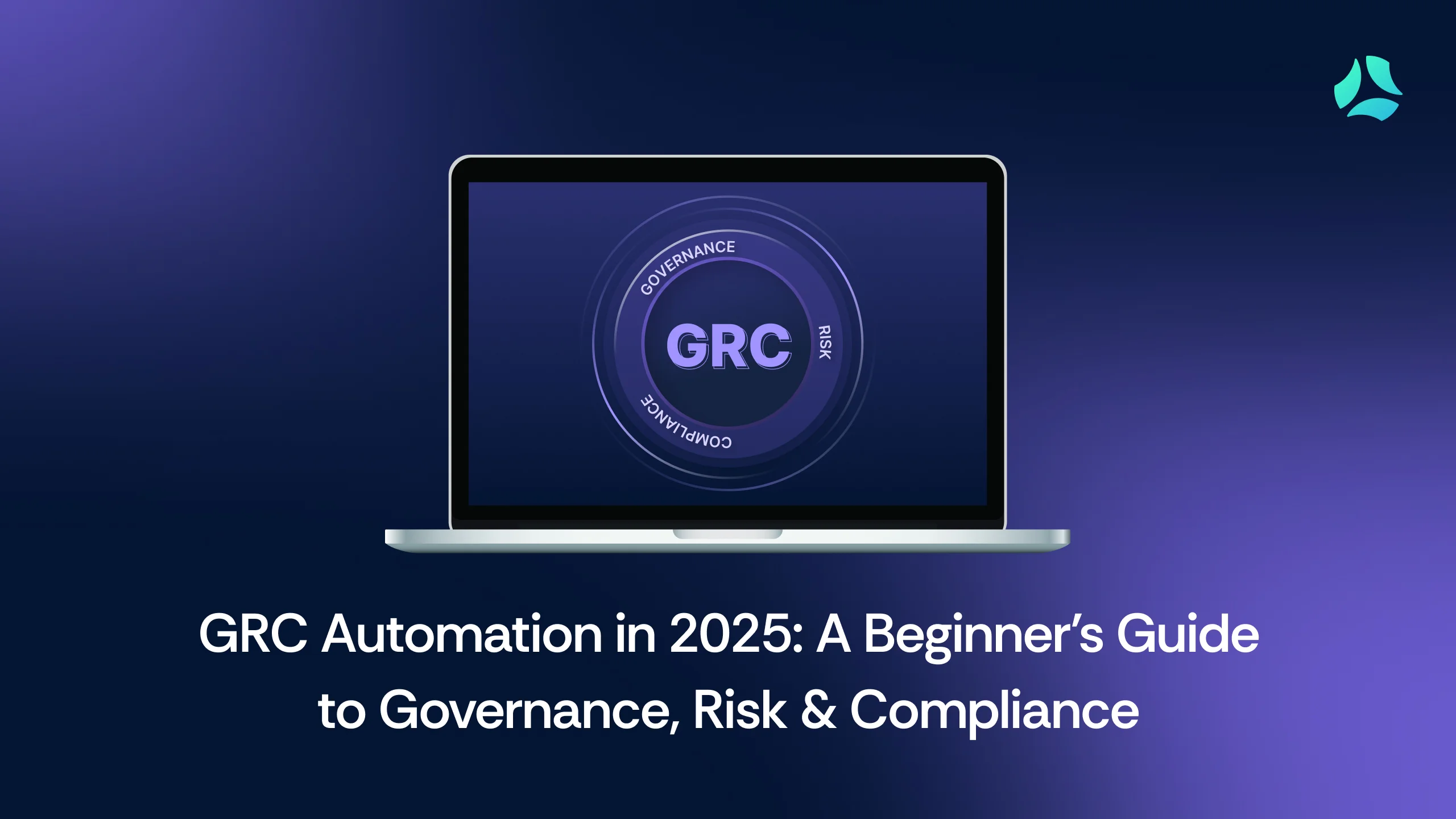GDPR Compliance Automation: A Scalable Approach to Privacy Management in 2025

Manual GDPR compliance processes are slow, error-prone, and hard to scale. When compliance data is scattered across siloed systems, even basic tasks like verifying identities or responding to DSARs become time-consuming and unreliable.
The result? Incomplete documentation, audit delays, and increased risk exposure.
GDPR compliance automation replaces fragmented workflows with continuous monitoring and intelligent systems. It reduces human error, accelerates response times, and gives your team room to focus on strategy, not repetitive admin.
In this article, we break down the core areas of GDPR compliance that benefit most from automation.
What is GDPR compliance automation?
GDPR compliance automation uses technology to streamline how you secure users' data and maintain privacy. These platforms assist in data mapping; however, data discovery accuracy depends entirely on the integrations you have in place across your technology stack. The more comprehensive your integrations, the more accurate your data discovery will be.With GDPR compliance automation, you can efficiently manage user consent, data subject access requests (DSARs), and third-party vendors.
GDPR compliance automation reduces manual efforts across key areas, including:
- Consent tracking and cookie compliance
- DSAR workflows
- Monitoring of data processing activity logs
- Policy updates
- Employee training records management
- Audit preparation and management
- Third-party risk and vendor compliance monitoring
Automated systems can help enforce policies, such as data minimization, and generate audit-ready compliance reports on demand, reducing manual overheads. Some GDPR requirements, such as legal review and complex DSAR exceptions, cannot be fully automated and require manual intervention.
The result? Less manual work, enhanced data protection, and a scalable privacy framework.
Top GDPR compliance tasks you can automate
Automating essential GDPR tasks helps you standardize processes and allows you to focus your efforts on core tasks for maintaining the security and privacy of users' data.
Here are the core GDPR compliance tasks you can automate:
1. Consent tracking and cookie compliance
Under the GDPR and ePrivacy Directive, you must obtain prior informed consent before placing non-essential cookies (like tracking or advertising cookies). GDPR governs personal data, while ePrivacy specifically regulates cookie consent within the EU.
With automation, you can:
- Dynamically display consent banners
- Record and sync user preferences across platforms
- Block non-essential cookies until users give their consent
- Auto-update cookie policies
- Maintain audit-ready logs
- Use geo-targeting features to ensure consistent compliance with regional regulations across all your digital properties
2. DSAR workflows
According to GDPR Article 12(3), you have one calendar month from receipt of a Data Subject Access Request to fulfill it, with possible extension of up to two additional months depending on the complexity and the number of requests.
Manual DSAR processing creates significant risks:
- Difficulty locating scattered personal data across systems
- Time-consuming identity verification processes
- Error-prone compilation of information
- Risk of incomplete or inaccurate responses or delayed responses leading to violations
Compliance automation tools accelerate DSAR workflows through:
- Configurable workflows with role-based task allocation
- Streamline data location and compilation
- Speedup identity verification processes
- Automated notifications and deadline tracking
- End-to-end audit trails for regulatory compliance
GDPR compliance automation deliver responses in a compliant format within the one month window, reducing operational overhead.
3. Data processing activity logs
Data processing activity logs, often referred to as Records of Processing Activities (RoPA), document how you collect, use, share, and secure personal data. Article 30 of the GDPR requires controllers and processors to maintain RoPA. While organizations with fewer than 250 employees may be exempt in some instances, this exemption doesn't apply if processing is risky, involves special categories of data, or isn't occasional.
GDPR automation help you build and maintain these records in real time.
- Use built-in RoPA templates to standardize documentation
- Automatically update records as activities change
- Keep logs searchable, complete, and audit-ready
- Simplify reporting to regulators
4. Policy updates and employee training records
Privacy policies help users understand how you manage their personal data and give them more control over their data. Automation tools streamline policy lifecycle management by:
- Automatically distribute the latest version to relevant stakeholders and track acknowledgements
- Maintain version control
- Make policies accessible across teams and departments
GDPR requires organizations to ensure that employees handling personal data receive appropriate training. GDPR compliance automation allows you to:
- Schedule training sessions based on roles and responsibilities
- Monitor training completion with automated reminders
5. Audit preparation and documentation
GDPR doesn't mandate formal audits; however, regulations require organizations to demonstrate accountability and compliance during regulatory inspections or internal assessments. The readiness of organizations for regulatory scrutiny or internal audit is an essential part of GDPR compliance, and a frequent stumbling block when records are scattered.
GDPR compliance automation platforms:
- Maintain centralized, real-time records of data processing activities, consent logs, training completion, and policy updates
- Store evidence of technical and procedural controls, such as encryption, access restrictions, training, and other measures, as proof of your compliance
- Generate audit-ready reports on demand
- Provide clear documentation for accountability and faster regulatory response
Benefits of automating GDPR compliance
Trying to manage GDPR compliance manually is like running a hospital with paper records. You might get by for a while, but as the number of patients grows, things start slipping: delays in care, misplaced files, and high-stakes errors.
The same goes for privacy compliance. Without automation, the burden grows heavier, the risk gets higher, and response times slow down. GDPR compliance automation doesn’t just improve operations; it brings the following benefits.
1. Save time and drive efficiency
With automation, you can avoid repetitive tasks such as data discovery, consent tracking, and responding to data subject requests. That means fewer back-and-forths, less admin burden, and faster turnaround times.
The insurance processing platform Diesta achieved a 50% reduction in audit preparation turnaround time by automating evidence collection.
Instead of chasing spreadsheets, your team can focus on what matters: strengthening strategy, not managing checklists.
2. Increase accuracy and reduce compliance risk
Manual compliance processes increase the likelihood of human error in data handling and documentation. Almost two-thirds (65%) of corporate risk and compliance professionals said using technology to streamline and automate manual processes would help reduce the complexity and cost of risk and compliance.
With automation, you can minimize manual intervention in information compilation for DSAR response or evidence collection, reducing the risk of incomplete or inaccurate data.
GDPR compliance automation ensures consistent rule application, accurate record-keeping, and fewer missed deadlines, all of which are critical for audit resilience.
3. Ensure centralized control and visibility
Automated platforms offer a unified dashboard to track all GDPR compliance activities, including data flows, consent records, and user requests. The centralized view enhances visibility, allowing you to monitor compliance in real time and generate on-demand, audit-ready reports.
The improved transparency enables you to get all stakeholders on the same page, enhancing collaboration during audits or cross-functional privacy assessments.
4. Experience scalability for growing teams
Manual compliance doesn’t scale. As organizations grow, manual compliance processes struggle to keep pace with the increasing volume of data, users, and regulatory demands. Automation enables you to align the pace of GDPR compliance with organizational growth.
GDPR compliance automation supports multi-location compliance, role-based access, and seamless integration with enterprise applications, ensuring sustained compliance. What you get is the ability to handle more users, data sources, and requests, all without the need for additional staff.
Common mistakes in GDPR automation
Recognizing and avoiding these common GDPR automation mistakes ensures successful implementation and efficiency gains:
1. Over-reliance on manual integrations
Manual data integration is fraught with challenges: data silos, inconsistent updates, and incomplete or inaccurate records. Automating data flows between systems is essential for maintaining accurate, real-time records and scaling compliance without bottlenecks.
2. Lack of role-based access controls
Role-based access control (RBAC) ensures that only authorized personnel can access or process personal data, a core requirement under the GDPR.
Without RBAC, you risk exposing sensitive data to unauthorized users. This can lead to data breaches and non-compliance. Failing to implement RBAC can result in over-privileged accounts, difficulty in tracking access, and a higher risk of security incidents.
3. Using non-compliant third-party tools
If you or your vendor uses third-party tools, evaluate whether these tools are GDPR compliant. These tools may mishandle consent, store data improperly, or lack audit capabilities, exposing you to regulatory fines and action.
Conduct due diligence and vet all external data processing tools to ensure they meet data protection, transfer, and processing requirements.
How Scrut enables GDPR automation?
Scrut automates key processes in the GDPR compliance value chain, from consent management and DSAR workflows to policy updates and audit preparation. Here’s how:
1. Out-of-the-box GDPR frameworks
Scrut's GDPR compliance framework includes pre-mapped controls, policies, and workflows, accelerating implementation. It's 50 expert-vetted GDPR-compliant policies that allow you to establish a robust data protection framework quickly. You can upload custom policies through its built-in policy editor that supports version control.
2. Pre-built DSAR workflows and consent modules
Streamline DSARs with Scrut's configurable workflows, role-based task allocation, and automated notifications. It helps you verify identity, generate responses in a compliant format, and track each request end-to-end with built-in audit trails, ensuring verifiable responses on time.
Consent modules capture, store, and update user preferences in real-time, ensuring the transparent, efficient, and consistent handling of user data rights.
3. Real-time compliance dashboard
With real-time dashboards, you can monitor key GDPR controls, risks, and policy compliance in real-time. Scrut’s compliance dashboard offers a consolidated view of compliance progress, risks, vendors, audits, and frameworks.
With real-time visibility into GDPR compliance, you can identify non-conformities early, track remediation efforts, and demonstrate an ongoing commitment to compliance.

Scrut allows you to customize your dashboards and tailor the view to highlight the metrics and information most relevant to your compliance and risk management goals.
4. Automated evidence collection from your tech stack
The tool has extensive integrations with multiple third-party applications, like HR systems, cloud platforms, and ticketing tools, to collect evidence for compliance automatically.
It captures up to 70% of required evidence automatically, pulling logs, control statuses, and audit trails across systems. This gives you a 100% audit-ready view, with every piece of evidence mapped to its corresponding GDPR control.
The evidence review planner flags upcoming and overdue items, so you can stay ahead of reviews and avoid last-minute scrambles.
5. Role-based task management
Scrut regulates data access by assigning GDPR-related tasks based on roles to limit access to sensitive data. The platform sets deadlines, tracks progress, sends reminders, and manages accountability through audit logs. This reduces the risk of compliance gaps and ensures critical issues are resolved on time.
Stay ahead with GDPR compliance automation
Manual processes can no longer keep pace with the data volume, complexity, and urgency of user privacy demands. GDPR compliance automation streamlines workflows, reduces risk, and helps you stay ahead of audits and evolving regulations.
Platforms like Scrut centralize GDPR compliance management through built-in templates aligned with GDPR requirements, auto-generated policy documents, automated data mapping tools, role-based task allocations, and near real-time compliance dashboards.
The result? Accurate, scalable, audit-ready privacy management, without the manual effort.
Schedule a demo today to see how Scrut can automate GDPR compliance for your team.
FAQs
Can GDPR compliance be automated?
GDPR compliance can be partially automated using compliance automation tools. You can automate specific processes, such as consent management, DSAR tracking, and audit logs. However, legal interpretation, contextual decision-making, and some manual controls are still mandatory.
What are the best tools for GDPR compliance?
The best tools for GDPR compliance include features such as consent management, automated data mapping, DSAR, and risk assessments. They also incorporate data breach notification workflows, retention policy enforcement, and data subject verification. Compliance automation tools, such as Scrut, help organizations efficiently meet GDPR requirements while maintaining transparency, accountability, and audit readiness.
How do I automate DSAR responses?
You can automate DSAR responses by using tools that verify identity, locate personal data across systems, compile it into a GDPR-compliant format, and track request status. However, sensitive DSARs often require manual review for legal and security reasons.
What is privacy compliance automation?
Privacy compliance automation refers to the use of technology to efficiently enforce data privacy practices, minimizing errors and enhancing audit readiness. In the context of GDPR, the automation supports compliance with Articles 12–23 (data subject rights), Article 30 (records of processing), and Article 33–34 (breach notifications). It helps organizations streamline tasks such as consent management, data mapping, policy enforcement, and handling user rights requests.
Is there GDPR compliance software?
GDPR compliance software enables organizations to automate specific data processing activities such as consent management, DSAR tracking, and audit logs. Leading governance, risk, and compliance (GRC) platforms, such as Scrut, offer GDPR compliance-specific modules to help organizations efficiently manage their regulatory obligations.


















